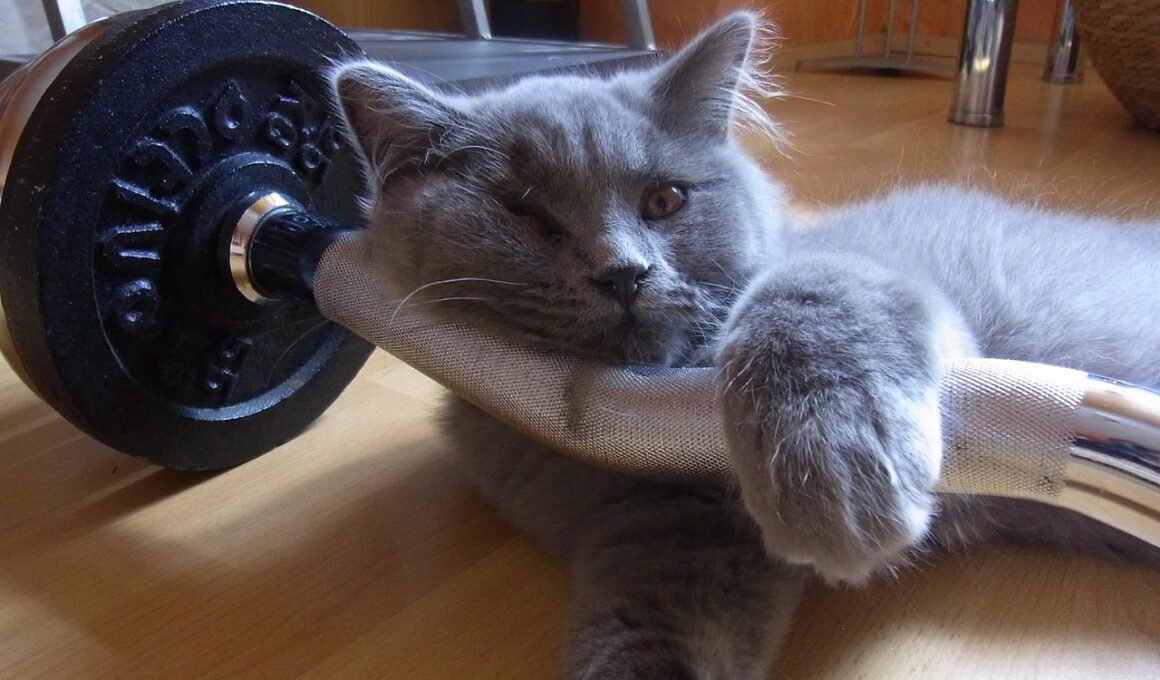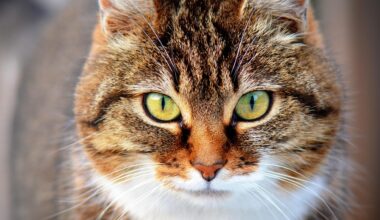Improving Your Cat’s Agility with Target Stick Exercises
Training your cat using target sticks can be an engaging way to improve agility and coordination. Cats are intelligent animals that thrive on mental stimulation, and target training offers numerous benefits. This technique involves using a stick with a target at the end, which encourages your cat to reach for and touch it. The key to successful training includes using positive reinforcement methods to motivate your cat. Start by introducing the target stick to your cat in a calm, quiet environment. Ensure that the stick’s target is bright and visually appealing to capture your cat’s attention. Reward your cat immediately upon touching the target with a treat, praise, or playtime. Consistency during training sessions is vital; keep them short and enjoyable to maintain your cat’s interest. Gradually increase the difficulty level, such as moving the target stick further away or incorporating obstacles. Eventually, your cat will develop agility and confidence, making these exercises beneficial for their overall well-being. Remember to be patient during training, and tailor sessions based on your cat’s unique personality and pace to foster a positive learning experience.
The Benefits of Target Stick Training
Target stick training offers numerous advantages for your feline friend and strengthens the bond between you and your cat. One significant benefit is that it enhances your cat’s cognitive functioning, improving their problem-solving skills. As cats engage with the target stick, they become more adept at making decisions and learning from their experiences. Additionally, this training method is an excellent physical exercise. The act of reaching for the target encourages movement, which is essential for keeping your cat fit and agile. Increased physical activity helps maintain a healthy weight and reduces the risk of obesity-related issues. Moreover, target stick exercises provide essential mental stimulation, helping to stave off boredom. Cats that engage in consistent training are generally happier and more well-adjusted. As their agility improves, they may gain more confidence in their abilities, which can positively affect their overall behavior. Remember to provide a variety of training scenarios to keep your cat intrigued and excited about the process. These sessions can also be a great way to socialize with your cat and improve their interaction with their environment, enabling them to become more adaptable and versatile.
To effectively implement target stick training, it’s important to choose the right tools for your sessions. Look for a target stick that is comfortable for you to hold and easy for your cat to see. You might consider sticks that feature a bright color or a fun design to attract your cat’s interest. Length is also an important factor; a stick that is too long can be cumbersome, while one that is too short may restrict movement. Additionally, ensure that the stick is safe for your cat to interact with. Avoid sharp edges or points that could cause injury, and always supervise their training sessions. You can also try using different types of targets, such as soft pom-poms or feathered toys, which can further entice your cat. Experimentation is key in discovering what your cat responds to best. Once you’ve chosen your tools, begin by familiarizing your cat with the target stick. Let them sniff it and explore before starting formal training. With patience and creativity, target stick training can become an enjoyable routine that enhances your cat’s agility and skills.
When starting target stick training, establishing a positive training environment is crucial for your cat’s success. Make sure to select a quiet, comfortable space free from distractions. Your cat will be more likely to engage with the target stick if they feel secure and relaxed. Begin your sessions by allowing your cat some time to acclimatize to the training area. Observe how your cat responds to the target stick and adjust your approach accordingly. Keep training sessions short, ideally around 5 to 10 minutes, to maintain your cat’s focus. Additionally, be mindful of your cat’s body language. If they seem bored or frustrated, take a break and try again later. It’s essential to celebrate their successes, no matter how small, to reinforce positive behaviors. Incorporate a variety of rewards like treats, toys, or affectionate touch to keep your cat motivated. As your cat starts touching the target stick regularly, gradually introduce more complex tasks. This method will help maintain their enthusiasm and make your training sessions more fruitful over time. By fostering a positive experience, you promote a healthy learning atmosphere for your cat.
Target stick exercises can become even more enjoyable for your cat when you incorporate additional activities. For example, you could add some jumps or tunnels as obstacles for your cat to navigate while following the target stick. This not only enhances their agility and coordination but also makes training more dynamic. Ensure that the obstacles are safe and adjustable to suit your cat’s skill level. Observe how your cat responds during these exercises and modify the obstacles to keep them challenged yet successful. It can also be beneficial to switch training locations to expose your cat to different environments. Training outdoors, in a secure, enclosed area can provide an exciting change of scenery, which may further engage your cat’s interest. Always remember to maintain a positive tone throughout the exercises and provide plenty of encouragement during these activities. Sharing training time with your cat not only improves agility but also strengthens your bond. As the training progresses, your cat will gain confidence in their capabilities and become more agile overall, drastically improving their physical capabilities and mental endurance.
Creating a Routine
Establishing a routine is essential when it comes to target stick training. Consistency will help your cat identify the training as a regular part of their day, making them more likely to participate willingly. Choose specific times during the day when your cat appears to be the most alert and playful. Integrating training sessions during these times will yield better results and a more engaged cat. For effective training, aim for short but frequent sessions spread throughout the week rather than infrequent long sessions. This way, your cat remains interested and does not become overwhelmed. Be sure to track your cat’s progress to identify areas for improvement or further focus. Maintaining a training journal can be a helpful tool to note which commands your cat excels at and those that may require more practice. Moreover, be adaptable in your training approach. If a particular method isn’t yielding expected results, be open to experimenting with variations. The goal is to foster an enjoyable training experience that both you and your cat look forward to, ultimately enhancing agility and physical fitness through fun and regular practice.
Finally, it is essential to understand that every cat is unique and may require different training methods or timelines. While some cats may quickly grasp the concept of target stick training, others may take more time to adapt to the idea. Therefore, patience is a fundamental virtue for every cat owner engaged in training. Always adapt your approach based on your cat’s individual personality, energy level, and responses to the exercises. Some cats may thrive under pressure, while others flourish with gentle encouragement. Celebrate every little achievement, as building confidence in your cat will significantly enhance their performance in the long run. Moreover, keep in mind that training isn’t just about agility; it’s also about enjoying quality time with your cat. Nurture a playful and positive atmosphere in your home that encourages playful interaction. Over time, the bond created through these sessions strengthens your relationship and enriches their lives. Remember, the ultimate goal of target stick training goes beyond agility; it’s an enjoyable inside activity to enhance the quality of life for both you and your beloved feline companion.


